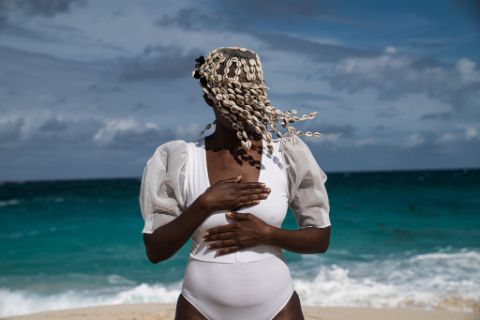When the Spirits Dance We
Adama Delphine Fawundu & Che Buford
Performance
Fri., 28.7.2023
20:30
Semra Ertan Garden

Adama Delphine Fawundu, Sea Whispers for Mami Wata at the shore of Guanahani, 2020
In Adama Delphine Fawundu’s work adorning sixteen flagpoles outside HKW’s Itō Noe Entrance, the colour blue is a reference to water and the capacity for its streams to witness many ages. The aesthetics of the flags weave together recurring West African traditional symbols and materials, highlighting a rootedness in knowledges that can also oppose contemporary narratives of hierarchy and oppression.
A flag to mark a territory, a flag to anchor the presence of higher beings whose stories and struggles are still felt in contemporary life, a flag to raise the voices of resistance that laid the ground for long oppressed communities to stand tall upon today, a flag for rethinking and re-engaging in congressing rituals that invite the spirits of human existence to a broader conversation. Fawundu’s work is itself a technology of remediation, as it contextualizes the space in which the flags stand as a space dense with intangible knowledge. The performative offering is accompanied by musician Che Buford, whose work explores the creation of new sonic narratives while engaging with memory and place. Proposing that memory also resides in the wind, the performance extends an invitation to collectively witness anew, imagine, and feel through some of the stories that made HKW what it is today. Fawundu and Buford guide the audience through a sonic and collective remembrance of HKW’s past by invoking its historical, political, and cultural narratives through time.